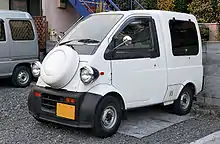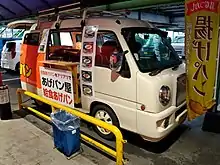Microvan
A microvan is a van or minivan that fits into Japanese kei car classification or similar, and is smaller than a mini MPV.


In China, these vehicles are nicknamed mian bao che ("bread loaf vehicle") because of their shape,[1] in a similar fashion, in several Hispanic American countries these vehicles are called Pan de Molde, which means "bread loaf".
Outside China and Japan, microvans are notably common in Southeast Asia, South Asia, Africa, Latin America and Middle East.
Microvans share similar characteristics with other sized MPVs by either seldomly or commonly consisting of sliding doors and carry 6/7/8 passengers. Since this category of a vehicle has fixed 3rd row seats, it implies that there is one vehicle for only passengers and another vehicle only for cargo and it doesn't have the 3rd row dedicated for both passengers and cargo purposes, these vehicle are not usually considered Multi Purpose Vehicles.
Economics
Tax and insurance benefits in some places make these models particularly inexpensive. For example, in rural Japan kei car vehicles are exempted from a certification that there is adequate parking available for the vehicle.[2] They are therefore widely used for small business in these places.
Design
The first vehicle to adopt the style of a van, with the engine installed in front of the driver was the 1970s Honda Life "StepVan". Some microvans utilize a drivetrain with the engine installed transversely, using front or all wheel drive, while others use a cab over approach where the engine is installed beneath the driver, while still utilizing all wheel drive or rear drive powertrains. Cab over variants usually share their chassis with kei truck derivatives from the same manufacturer.
Most microvans have two swinging front doors, two sliding rear doors and a large tailgate. Seating can vary from two to nine; these seats are usually very thin and vertical to optimise room. The side windows in commercial-only versions of microvans are replaced by metallic panels and are sometimes called "blind van". Some models also feature pick-up variants with one or two seat rows. Engines usually have displacements under 1.0 litre; for example, Japanese microvans have a limit of 660 cc. Outside the Japanese market, there are microvans available with 850 cc to 1.6 litre engines.
The kei car regulation is used only in Japan, though other Asian automakers also design microvans with similar characteristics. The microvans are commonly known as "kei one box" in Japan alongside their pick-up version twins known as kei truck.
Safety
Due to the inherent compact size, lack of crumple zones, and low weight these vehicles tend to fare poorly in collisions with other vehicles and objects, and as a result are not recommended to be driven at higher speeds. The IIHS in the USA recommends these vehicles are only driven on private land and not on public roads due to their poor safety in accidents.
Gallery
Kei microvans
 Subaru Sambar Van sixth generation
Subaru Sambar Van sixth generation.jpg.webp) Honda Acty Van third generation
Honda Acty Van third generation Suzuki Every fifth generation
Suzuki Every fifth generation Mitsubishi Minicab Van fifth generation
Mitsubishi Minicab Van fifth generation Subaru Dias Wagon Classic Food truck
Subaru Dias Wagon Classic Food truck
Non-kei microvans
%252C_Kajang.jpg.webp) Suzuki Every Landy/E-RV or Maruti Versa
Suzuki Every Landy/E-RV or Maruti Versa_(front)%252C_Kajang.jpg.webp)
 Subaru Domingo second generation
Subaru Domingo second generation Daihatsu Atrai Seven
Daihatsu Atrai Seven Mitsubishi Town Box Wide
Mitsubishi Town Box Wide
See also
References
- Chinese Hero Cars: The Mian Bao Che Archived 2008-10-11 at the Wayback Machine - China Car Times
- Nunn, Peter (January–February 2005). "Minicars: Cheap and Cheerful". JAMA. Retrieved 2012-05-10.